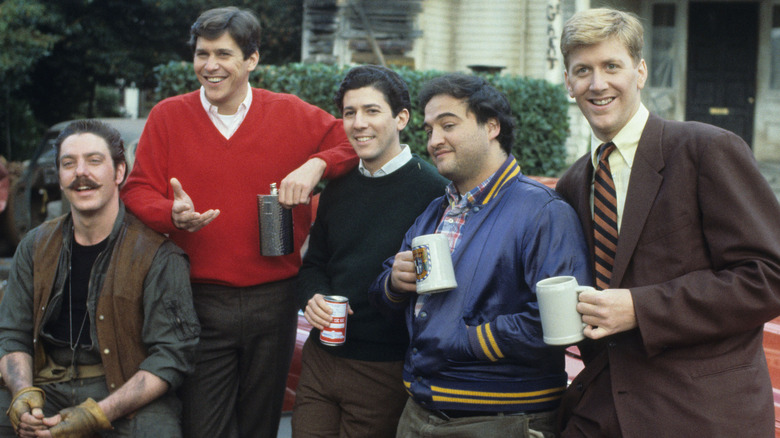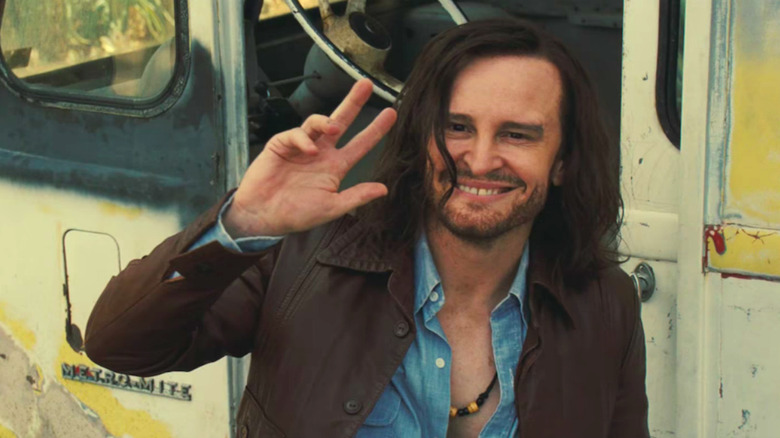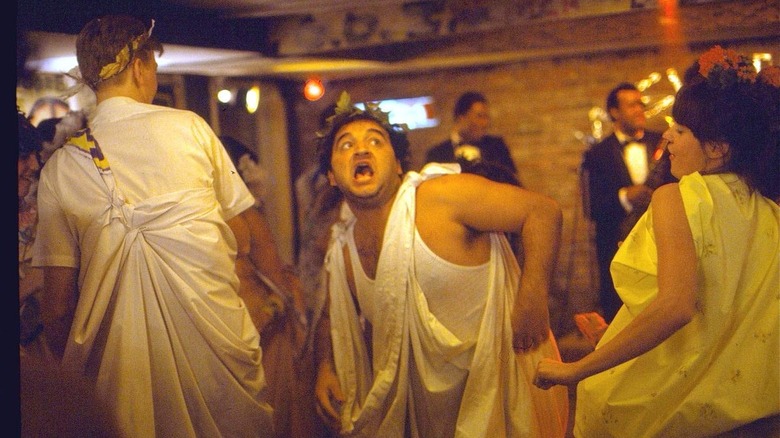Animal House Was Once A Completely Different Movie About Charles Manson In High School
"National Lampoon's Animal House" seems like a no-brainer idea in hindsight, a "slobs vs. snobs" comedy that jumped on the '50s/'60s nostalgia wave of the '70s while being generic enough to remind several generations of their wild college days. However, as the flagship theatrical effort from the National Lampoon brand, "Animal House" was hardly written overnight.
In fact, the movie that would eventually become "Animal House" went through a number of concepts before landing on the adventures of Faber College's Delta Tau Chi fraternity. Thanks to there being no set idea for the film besides bearing the National Lampoon name, the movie underwent several increasingly strange and possibly unfilmable permutations. One of those drafts featured notorious cult leader and murderer Charles Manson as the lead and took place in a high school instead of a college. While incredibly offensive and irresponsible, it was enough to attract the up-and-coming director John Landis to the project, who would go on to help shape "Animal House" into the film we know today.
Now wait a minute: the strange history of the National Lampoon movie
One of the explanations for such a strange script even seeing the light of day is the fact that the entire concept of a National Lampoon movie wasn't born from greed, creative desire, or even as a goof. Instead, it was "National Lampoon Magazine" head Matty Simmons' who was desperate to hold onto his most valuable writer, Lampoon founder Douglas Kenney. According to Landis, "Doug was getting fed up at the magazine and Matty Simmons was freaking out because he knew that Doug was the brains. So he said, 'Doug, don't you know National Lampoon is gonna make a movie?' And Doug said, 'Oh really?' And that's how he kept him for another year or two."
During those couple years, Kenney wrote the first version of a National Lampoon movie, allegedly entitled "Laser Orgy Girls," a script that Landis purports to have never seen but heard "it was unacceptable." Meanwhile, Simmons had brought on Ivan Reitman, who had produced "The National Lampoon Show" off-Broadway and worked with a bevy of young comedians on that project, including actor and writer Harold Ramis.
According to Landis, it was Ramis and Kenney who wrote the infamous "Charles Manson in high school" version (which may or may not have retained the title "Laser Orgy Girls"). Landis read that draft, and admitted that it had "some brilliant stuff in it, but it was too outrageous." While the director considered that script unsuitable, he was particularly taken by its opening sequence, a scene which has the camera move through a "fortress prison" and continues tracking deeper down foreboding hallways before finally settling on "a padded cell, and in the corner is this man in a straight jacket." Landis explained, "You see that it's Charles Manson ... and he looks at the camera and says, 'Is it hot in here or am I crazy?'"
Reacting to that script, Simmons balked, with Landis recalling his response being, "'You can't have all this gang-rape stuff. Put it in college!'" At which point, Kenney and Ramis added Chris Miller to their writers room, thanks to Miller's own writing about his fraternity experiences at Dartmouth. With the trio able to brainstorm a variety of characters and scenarios recalling their various college years in the early '60s, "Animal House" as we know it was finally born.
What a wonderful world this could be: refining 'Animal House'
Even though the "Animal House" script had been smartly turned into a college comedy rather than a movie featuring a cult orgy inside a high school, the film still had its own speed bumps along the way to production. Landis remembers reading the first draft of the script, finding it faithful to the "National Lampoon Magazine" brand of off-color and offensive material, which he said was "very funny but very white elitist, racist, anti-Semitic — all the Lampoon earmarks." As Landis recalled, "For many years, no Jews or Blacks were allowed to be on the Harvard Lampoon staff." The filmmaker knew that such a script needed work before it could get greenlit by a major studio like Universal, let alone get in front of a camera.
Thanks to a Universal executive seeing an early cut of Landis' "Kentucky Fried Movie," the director was hired onto the "Animal House" project, "basically to supervise the rewrite." While there was some expected tension in the hiring of yet another writer, Landis astutely observed, "Everybody in the movie can't be a pig. You have to have good guys and bad guys." Thus, Landis became instrumental in forming the final movie's "slobs vs. snobs" structure, with characters like Otter (Tim Matheson), Boon (Peter Riegert) and Bluto (John Belushi) becoming more lovable underdogs in addition to being crass college boys.
While "Animal House" would go on to be massively successful and influential, kicking off a decade plus of similarly themed and structured comedy features, Landis (who has his own history of unmade scripts) reckons that the original, more offensive and unruly script would have a better chance being made today than it ever would have back then. "It could probably get made now," he says of the Manson in high school draft. Whether that idea ever sees the light of day or not, we have Landis to thank for his good taste in not acquiescing to bad taste.


